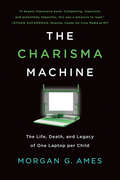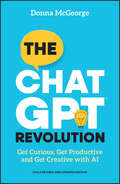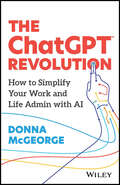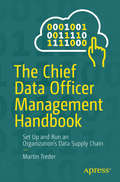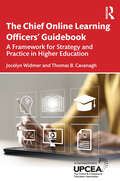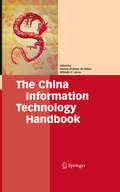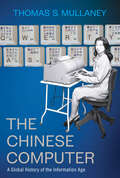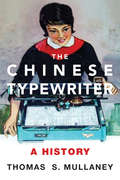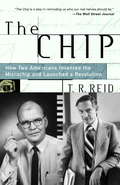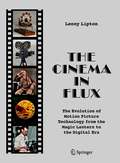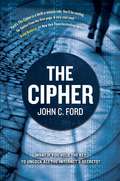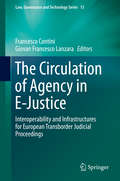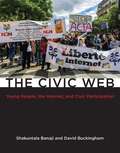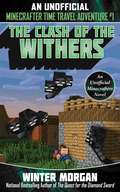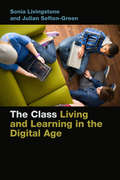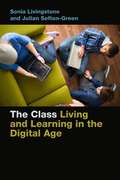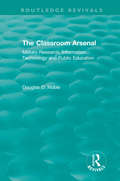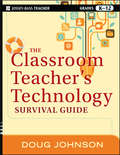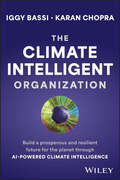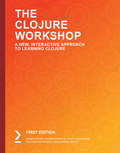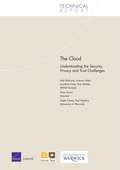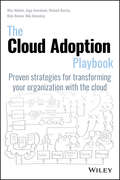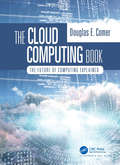- Table View
- List View
The Charisma Machine: The Life, Death, and Legacy of One Laptop per Child (Infrastructures)
by Morgan G. AmesA fascinating examination of technological utopianism and its complicated consequences.In The Charisma Machine, Morgan Ames chronicles the life and legacy of the One Laptop per Child project and explains why—despite its failures—the same utopian visions that inspired OLPC still motivate other projects trying to use technology to “disrupt” education and development. Announced in 2005 by MIT Media Lab cofounder Nicholas Negroponte, One Laptop per Child promised to transform the lives of children across the Global South with a small, sturdy, and cheap laptop computer, powered by a hand crank. In reality, the project fell short in many ways—starting with the hand crank, which never materialized. Yet the project remained charismatic to many who were captivated by its claims of access to educational opportunities previously out of reach. Behind its promises, OLPC, like many technology projects that make similarly grand claims, had a fundamentally flawed vision of who the computer was made for and what role technology should play in learning.Drawing on fifty years of history and a seven-month study of a model OLPC project in Paraguay, Ames reveals that the laptops were not only frustrating to use, easy to break, and hard to repair, they were designed for “technically precocious boys”—idealized younger versions of the developers themselves—rather than the children who were actually using them. The Charisma Machine offers a cautionary tale about the allure of technology hype and the problems that result when utopian dreams drive technology development.
The ChatGPT Revolution: Get Curious, Get Productive and Get Creative with AI
by Donna McGeorgeLearn how to simplify your life with AI in this essential guide — now fully updated and revised, with even more ideas to spark creativity and boost efficiency The ChatGPT Revolution is the ultimate quick-start guide to unlocking the power of generative AI. We’re on the edge of an AI revolution … but what does that mean for you? It’s time to get curious about how the latest tech can help you handle your everyday load, at work and at home! Whether you’re overwhelmed by repetitive, time-consuming tasks or you’re simply looking for a fresh injection of creativity, ChatGPT has got your back. With this essential handbook, you’ll learn how quickly and easily apps like ChatGPT can turn your to-do list into a ta-da list. From emails and reports to planning your next meal or vacation, generative AI can help you simplify your daily tasks and responsibilities. The ChatGPT Revolution shows you exactly how to use this innovative tech to save on time and stress. Sharing practical tips and fun ideas, acclaimed productivity expert Donna McGeorge unpacks everything you need to know. Learn how generative AI is already being used in everyday life — and how tools like ChatGPT are transforming the future of work and life admin Understand the different tasks that AI tools like ChatGPT, Copilot, and DALL-E can do — and when and how to use these tools most effectively Get step-by-step advice for writing smart, specific prompts and follow-up queries to produce better results Discover tips for using ChatGPT on the go, with the mobile app and voice and photo capability Take control, revitalise your workflows, and overcome procrastination and creative blocks — with entertaining examples and activities for work, home, creative writing, and more Whether you’re a busy professional or you simply want an answer to the dreaded question ‘What’s for dinner?,’ The ChatGPT Revolution reveals how generative AI can make your life easier. AI technologies are here to stay. This is your invitation to join the revolution. Pick up this book and learn how to harness the power of AI, so you can free up more time and energy for the things that truly matter.
The ChatGPT Revolution: How to Simplify Your Work and Life Admin with AI
by Donna McGeorgeThe essential guide to using AI in your everyday life The ChatGPT Revolution is the ultimate quick-start guide to unlocking the power of AI tool ChatGPT. We’re on the edge of an AI revolution… but what does that mean for you? It’s time to get curious about how the latest tech can help you handle your everyday load, at work and at home! Whether you’re overwhelmed by repetitive, time-consuming tasks or you’re simply looking for a fresh injection of creativity, ChatGPT is the virtual assistant that’s got your back. With this essential handbook, you’ll learn how quickly and easily ChatGPT can turn your to-do list into a ta-da list. From helping you write emails and reports to planning your next meal or vacation, ChatGPT offers a new way to simplify your daily tasks and responsibilities. The ChatGPT Revolution shows you exactly how to use this innovative tech to save on time and stress. Sharing practical tips and fun ideas, author and acclaimed productivity expert Donna McGeorge unpacks everything you need to know. Learn how AI is already being used in everyday life — and how tools like ChatGPT are transforming the future of work and life admin Understand the different tasks ChatGPT can do and when and how to use it most effectively Get step-by-step advice for writing smart, specific prompts and follow-up queries that will produce better results Get curious and get productive, with entertaining examples, advice, and activities to take control, revitalise your workflows, and overcome procrastination and creative blocksWhether you’re a busy professional or you simply want an answer to the dreaded question ‘What’s for dinner?,’ The ChatGPT Revolution reveals how you can use ChatGPT as a tool to simplify your life. AI technologies are here to stay: this is your invitation to join the revolution. Pick up this book and learn how to harness the power of AI, so you can free up more time and energy for the things that truly matter.
The Chief Data Officer Management Handbook: Set Up and Run an Organization’s Data Supply Chain
by Martin TrederThere is no denying that the 21st century is data driven, with many digital industries relying on careful collection and analysis of mass volumes of information. A Chief Data Officer (CDO) at a company is the leader of this process, making the position an often daunting one. The Chief Data Officer Management Handbook is here to help.With this book, author Martin Treder advises CDOs on how to be better prepared for their swath of responsibilities, how to develop a more sustainable approach, and how to avoid the typical pitfalls. Based on positive and negative experiences shared by current CDOs, The Chief Data Officer Management Handbook guides you in designing the ideal structure of a data office, implementing it, and getting the right people on board.Important topics such as the data supply chain, data strategy, and data governance are thoughtfully covered by Treder. As a CDO it is important to use your position effectively with your entire team. The Chief Data Officer Management Handbook allows all employees to take ownership in data collaboration. Data is the foundation of present and future tech innovations, and you could be the leader that makes the next big impact.What You Will LearnApply important elements of effective data managementGain a comprehensive overview of all areas of data (which are often managed independently Work with the data supply chain, from data acquisition to its usage, a review of all relevant stakeholders, data strategy, and data governanceWho This Book is ForCDOs, data executives, data advisors, and all professionals looking to understand about how a data office functions in an organization.
The Chief Online Learning Officers' Guidebook: A Framework for Strategy and Practice in Higher Education
by Thomas B. Cavanagh Jocelyn WidmerThe Chief Online Learning Officers’ Guidebook explores the essential competencies required of Chief Online Learning Officers (COLOs) using insights from real-world leadership and expert perspectives from higher education. Digital and online learning have become strategic priorities for higher education institutions working toward enrollment growth, learner engagement, revenue generation, brand diversification, and enhanced student flexibility following the initial COVID-19 lockdown. This book’s unique framework substantiates and demonstrates key competencies that define the COLO role and enable advancements in the practice of online and digital higher education. Featuring over 50 contributions from COLOs, Chief Information Officers (CIOs), university presidents, and other higher education leaders, this UPCEA-endorsed guide offers practical strategies and comprehensive guidance for both current and aspiring COLOs.
The China Information Technology Handbook
by Miltiadis D. Lytras Patricia Ordóñez de PablosThis handbook is a reference for those interested in information technologies and emerging management practices in China. The emphasis on information technologies and management provides a unique proposition and gives characteristics of flexibility and adoption to diverse audiences. The subject area is a combination of global information technology and management along with strategic management of IT. The handbook exploits state-of-the-art and emerging trends in theory and technology. This handbook is primarily designed for a professional and academic audience.
The Chinese Computer: A Global History of the Information Age
by Thomas S. MullaneyThe fascinating, untold story of how the Chinese language overcame unparalleled challenges and revolutionized the world of computing.A standard QWERTY keyboard has a few dozen keys. How can Chinese—a language with tens of thousands of characters and no alphabet—be input on such a device? In The Chinese Computer, Thomas S. Mullaney sets out to resolve this paradox, and in doing so, discovers that the key to this seemingly impossible riddle has given rise to a new epoch in the history of writing—a form of writing he calls &“hypography.&” Based on fifteen years of research, this pathbreaking history of the Chinese language charts the beginnings of electronic Chinese technology in the wake of World War II up through to its many iterations in the present day.Mullaney takes the reader back through the history and evolution of Chinese language computing technology, showing the development of electronic Chinese input methods—software programs that enable Chinese characters to be produced using alphanumeric symbols—and the profound impact they have had on the way Chinese is written. Along the way, Mullaney introduces a cast of brilliant and eccentric personalities drawn from the ranks of IBM, MIT, the CIA, the Pentagon, the Taiwanese military, and the highest rungs of mainland Chinese establishment, to name a few, and the unexpected roles they played in developing Chinese language computing. Finally, he shows how China and the non-Western world—because of the hypographic technologies they had to invent in order to join the personal computing revolution—&“saved&” the Western computer from its deep biases, enabling it to achieve a meaningful presence in markets outside of the Americas and Europe.An eminently engaging and artfully told history, The Chinese Computer is a must-read for anyone interested in how culture informs computing and how computing, in turn, shapes culture.
The Chinese Typewriter: A History (The\mit Press Ser.)
by Thomas S. MullaneyHow Chinese characters triumphed over the QWERTY keyboard and laid the foundation for China's information technology successes today.Chinese writing is character based, the one major world script that is neither alphabetic nor syllabic. Through the years, the Chinese written language encountered presumed alphabetic universalism in the form of Morse Code, Braille, stenography, Linotype, punch cards, word processing, and other systems developed with the Latin alphabet in mind. This book is about those encounters—in particular thousands of Chinese characters versus the typewriter and its QWERTY keyboard. Thomas Mullaney describes a fascinating series of experiments, prototypes, failures, and successes in the century-long quest for a workable Chinese typewriter. The earliest Chinese typewriters, Mullaney tells us, were figments of popular imagination, sensational accounts of twelve-foot keyboards with 5,000 keys. One of the first Chinese typewriters actually constructed was invented by a Christian missionary, who organized characters by common usage (but promoted the less-common characters for “Jesus" to the common usage level). Later came typewriters manufactured for use in Chinese offices, and typewriting schools that turned out trained “typewriter girls” and “typewriter boys.” Still later was the “Double Pigeon” typewriter produced by the Shanghai Calculator and Typewriter Factory, the typewriter of choice under Mao. Clerks and secretaries in this era experimented with alternative ways of organizing characters on their tray beds, inventing an input method that was the first instance of “predictive text.”Today, after more than a century of resistance against the alphabetic, not only have Chinese characters prevailed, they form the linguistic substrate of the vibrant world of Chinese information technology. The Chinese Typewriter, not just an “object history” but grappling with broad questions of technological change and global communication, shows how this happened.A Study of the Weatherhead East Asian InstituteColumbia University
The Chip: How Two Americans Invented the Microchip and Launched a Revolution
by T. R. ReidBarely fifty years ago a computer was a gargantuan, vastly expensive thing that only a handful of scientists had ever seen. The world's brightest engineers were stymied in their quest to make these machines small and affordable until the solution finally came from two ingenious young Americans. Jack Kilby and Robert Noyce hit upon the stunning discovery that would make possible the silicon microchip, a work that would ultimately earn Kilby the Nobel Prize for physics in 2000. In this completely revised and updated edition of The Chip, T. R. Reid tells the gripping adventure story of their invention and of its growth into a global information industry. This is the story of how the digital age began.
The Cinema in Flux: The Evolution of Motion Picture Technology from the Magic Lantern to the Digital Era
by Lenny LiptonThe first of its kind, this book traces the evolution of motion picture technology in its entirety. Beginning with Huygens' magic lantern and ending in the current electronic era, it explains cinema’s scientific foundations and the development of parallel enabling technologies alongside the lives of the innovators. Product development issues, business and marketplace factors, the interaction of aesthetic and technological demands, and the patent system all play key roles in the tale. The topics are covered sequentially, with detailed discussion of the transition from the magic lantern to Edison’s invention of the 35mm camera, the development of the celluloid cinema, and the transition from celluloid to digital. Unique and essential reading from a lifetime innovator in the field of cinema technology, this engaging and well-illustrated book will appeal to anyone interested in the history and science of cinema, from movie buffs to academics and members of the motion picture industry.
The Cipher
by John C. Ford"Ford's The Cipher is a thrill-a-minute ride. A very cool read."--David Baldacci You think your emails are private?Your credit card number is secure?That stock trades, government secrets, and nuclear codes are safe?...th1nk aga1n.Robert "Smiles" Smylie is not a genius. He feels like he's surrounded by them, though, from his software mogul dad to his brainy girlfriend to his oddball neighbor Ben, a math prodigy. When Ben cracks an ancient, real-life riddle central to modern data encryption systems, he suddenly holds the power to unlock every electronic secret in the world--and Smiles finally has a chance to prove his own worth. Smiles hatches a plan to protect Ben from the government agents who will stop at nothing to get their hands on his discovery. But as he races from a Connecticut casino to the streets of Boston, enlisting the help of an alluring girl, Smiles comes to realize the most explosive secrets don't lie between the covers of Ben's notebook--they're buried in his own past. Eerily close to reality and full of shocking twists, this techno-thriller reveals how easily the private can become public, and just how dangerous it can be to encrypt our personal histories.
The Circulation of Agency in E-Justice
by Giovan Francesco Lanzara Francesco ContiniThis book contributes to an understanding of the dynamic complexities involved in the design of e-justice applications that enable online trans-border judicial proceedings in Europe. It provides answers to critical questions with practical relevance: How should online trans-border judicial proceedings be designed in order to deliver effective and timely justice to European citizens, businesses and public agencies? How can the circulation of judicial agency across Europe be facilitated? Based on extensive research, the book explores and assesses the complex entanglements between law and technology, and between national and European jurisdictions that emerge when developing even relatively simple e-services such as those supporting the European small claims procedure and European payment orders. In addition to providing a strong theoretical framework and an innovative approach to e-justice design, this book includes case studies that are based on a common methodology and theoretical framework. It presents original empirical material on the development of e-government systems in the area of European justice. Finally, it introduces the design strategies of Maximum Feasible Simplicity and Maximum Manageable Complexity and, based on them, it proposes architectural and procedural solutions to enhance the circulation of judicial agency.
The Civic Web: Young People, the Internet and Civic Participation
by Shakuntala Banaji David BuckinghamThere has been widespread concern in contemporary Western societies about declining engagement in civic life; people are less inclined to vote, to join political parties, to campaign for social causes, or to trust political processes. Young people in particular are frequently described as alienated or apathetic. Some have looked optimistically to new media -- and particularly the Internet -- as a means of revitalizing civic life and democracy. Governments, political parties, charities, NGOs, activists, religious and ethnic groups, and grassroots organizations have created a range of youth-oriented websites that encourage widely divergent forms of civic engagement and use varying degrees of interactivity. But are young people really apathetic and lacking in motivation? Does the Internet have the power to re-engage those disenchanted with politics and civic life? Based on a major research project funded by the European Commission, this book attempts to understand the role of the Internet in promoting young peoples participation. Examples are drawn from Hungary, the Netherlands, Slovenia, Spain, Sweden, Turkey, and the United Kingdom -- countries offering contrasting political systems and cultural contexts. The book also addresses broader questions about the meaning of civic engagement, the nature of new forms of participation, and their implications for the future of civic life.
The Civic Web: Young People, the Internet, and Civic Participation (The John D. and Catherine T. MacArthur Foundation Series on Digital Media and Learning)
by Shakuntala Banaji David BuckinghamAn investigation of how governments, organizations, and groups use the Internet to promote civic and political engagement among young people.There has been widespread concern in contemporary Western societies about declining engagement in civic life; people are less inclined to vote, to join political parties, to campaign for social causes, or to trust political processes. Young people in particular are frequently described as alienated or apathetic. Some have looked optimistically to new media—and particularly the Internet—as a means of revitalizing civic life and democracy. Governments, political parties, charities, NGOs, activists, religious and ethnic groups, and grassroots organizations have created a range of youth-oriented websites that encourage widely divergent forms of civic engagement and use varying degrees of interactivity. But are young people really apathetic and lacking in motivation? Does the Internet have the power to re-engage those disenchanted with politics and civic life? Based on a major research project funded by the European Commission, this book attempts to understand the role of the Internet in promoting young people's participation. Examples are drawn from Hungary, the Netherlands, Slovenia, Spain, Sweden, Turkey, and the United Kingdom—countries offering contrasting political systems and cultural contexts. The book also addresses broader questions about the meaning of civic engagement, the nature of new forms of participation, and their implications for the future of civic life.
The Clash of the Withers: An Unofficial Minecrafters Time Travel Adventure (Unofficial Minecrafters Time Travel #1)
by Winter MorganFarmer Brett and his apprentice Joe are happy to build a new farm for their town of Meadow Mews. But during construction the pair falls down a hole and land in an unknown place and time!Discovering that they are in the middle of the historic Wither War, they find out that their history is far more complicated than they learned in school. After witnessing the first creeper explosion, Brett and Joe are recruited into an army to fight the monsters. Should they use their knowledge of the past to help end the battle? Or will this impact the future of the Overworld? And what will it mean for them getting home? Join Brett and Joe as they travel through time to find their way home in this new series from bestselling author Winter Morgan.
The Class: Living and Learning in the Digital Age (Connected Youth and Digital Futures #1)
by Julian Sefton-Green Sonia LivingstoneAn intimate look at how children network, identify, learn and grow in a connected world.Read Online at connectedyouth.nyupress.orgDo today’s youth have more opportunities than their parents? As they build their own social and digital networks, does that offer new routes to learning and friendship? How do they navigate the meaning of education in a digitally connected but fiercely competitive, highly individualized world?Based upon fieldwork at an ordinary London school, The Class examines young people's experiences of growing up and learning in a digital world. In this original and engaging study, Livingstone and Sefton-Green explore youth values, teenagers’ perspectives on their futures, and their tactics for facing the opportunities and challenges that lie ahead. The authors follow the students as they move across their different social worlds—in school, at home, and with their friends, engaging in a range of activities from video games to drama clubs and music lessons. By portraying the texture of the students’ everyday lives, The Class seeks to understand how the structures of social class and cultural capital shape the development of personal interests, relationships and autonomy. Providing insights into how young people’s social, digital, and learning networks enable or disempower them, Livingstone and Sefton-Green reveal that the experience of disconnections and blocked pathways is often more common than that of connections and new opportunities.
The Class: Living and Learning in the Digital Age (Connected Youth and Digital Futures #1)
by Sonia Livingstone Julian Sefton-GreenAn intimate look at how children network, identify, learn and grow in a connected world.Read Online at connectedyouth.nyupress.orgDo today’s youth have more opportunities than their parents? As they build their own social and digital networks, does that offer new routes to learning and friendship? How do they navigate the meaning of education in a digitally connected but fiercely competitive, highly individualized world?Based upon fieldwork at an ordinary London school, The Class examines young people's experiences of growing up and learning in a digital world. In this original and engaging study, Livingstone and Sefton-Green explore youth values, teenagers’ perspectives on their futures, and their tactics for facing the opportunities and challenges that lie ahead. The authors follow the students as they move across their different social worlds—in school, at home, and with their friends, engaging in a range of activities from video games to drama clubs and music lessons. By portraying the texture of the students’ everyday lives, The Class seeks to understand how the structures of social class and cultural capital shape the development of personal interests, relationships and autonomy. Providing insights into how young people’s social, digital, and learning networks enable or disempower them, Livingstone and Sefton-Green reveal that the experience of disconnections and blocked pathways is often more common than that of connections and new opportunities.
The Classroom Arsenal: Military Research, Information Technology and Public Education (Routledge Revivals)
by Douglas D. NobleA quarter of a century after its initial publication, The Classroom Arsenal remains pivotal in understanding and challenging the relentless promotion of technology to reform education. This seemingly benign education technology juggernaut carries forward the momentum of military agendas in man-machine systems detailed in the book. Promoters continue to flood schools with technology and its (still unfulfilled) promise of cutting edge, "personalized learning." Meanwhile, they continue as well their insatiable pursuit of federal funding, educational legitimacy, corporate profits, and access to student subjects and their accumulated learning data for product development. Less understood, though, is a companion enterprise, there from the start, to replace teaching and learning in traditional classrooms by efficient automated systems that manage and monitor human cognition and learning for high-performance systems, from weapons systems to high tech corporations. As education is moved imperceptibly away from its traditional humanistic aims and from the classroom itself, the goal of this human engineering project, the depersonalized accumulation of cognitive components for a 21st century militarized economy, best befits the book’s original title: "The Human Arsenal." This ongoing military/corporate-sponsored enterprise continues to impact education today, largely unnoticed. One example is the federally-funded Advanced Distributed Learning Initiative (ADL), which has been a major force behind the implementation of electronic learning systems, now used in all Defense Department and federal employee training. With the Defense Advanced Research Project Agency (ARPA) ADL is developing structures to capture students’ soft skills, and the Army Research Laboratory is developing "intelligent tutoring systems" to enable "instructional management of affect, engagement, and grit (perseverance)." ADL through the Department of Defense has developed Experience API, a learning technology that can monitor all student online and offline interactions and archive these in date lockers or learning record stores. ADL has already impacted thousands of school districts through nonprofits such as IMS Global and Future Ready Schools, part of an industry massively subsidized by high tech corporations and valued at $255 billion annually. A $90 million Advanced Research Projects Agency for Education (ARPA-ED), modeled after the military’s ARPA, has been proposed to fund "dramatic breakthroughs in learning and teaching." These include "digital tutors as effective as personal tutors" and, with the Navy’s Full Spectrum Learning project, "data collection tools for personalized education modeled after corporate data analysis that identifies consumer patterns and preferences." ADL is just one example of how the military/corporate ed tech enterprise is changing public education by hollowing it out into something that can be digitized, data-driven, automated, and monitored. Its promoters envision education as children interacting with online learning systems where, based on past performance, algorithms will serve up what each student needs to know next. Through this digital curriculum, students create virtual educational identities at very young ages and learning devices are watching students as much as students are watching them. Such is the education landscape presaged by The Classroom Arsenal a quarter century ago, whose origins and trajectories need to be deeply understood now more than ever.
The Classroom Teacher'S Technology Survival Guide
by Doug JohnsonA comprehensive guide for integrating educational technology in the K-12 classroom This is a must-have resource for all K-12 teachers and administrators who want to really make the best use of available technologies. Written by Doug Johnson, an expert in educational technology, The Classroom Teacher's Technology Survival Guide is replete with practical tips teachers can easily use to engage their students and make their classrooms places where both students and teachers will enjoy learning. Covers the most up-to-date technologies and how they can best be used in the classroom Includes advice on upgrading time-tested educational strategies using technology Talks about managing "disruptive technologies" in the classroom Includes a wealth of illustrative examples, helpful suggestions, and practical tips This timely book provides a commonsense approach to choosing and using educational technology to enhance learning.
The Climate Intelligent Organization: Build a Prosperous and Resilient Future for the Planet Through AI-Powered Climate Intelligence
by Iggy Bassi Karan ChopraLearn to make sound business decisions on a rapidly changing planet In The Climate Intelligent Organization, renowned entrepreneurs and climate intelligence pioneers Iggy Bassi and Karan Chopra, deliver an intuitive and practical guide to the transformative power of AI-driven Unified Climate Intelligence (UCI). Written with the business practitioner in mind, the book showcases how holistic climate analysis can be integrated into decisions, growth plans, and investments as organizations navigate the challenges and opportunities of climate change. You'll discover: How UCI can redefine competitive advantage and reshape leadership. Strategies to improve climate-related financial performance. A roadmap for driving resilient value creation in the new climate economy. Perfect for managers, executives, directors, policy makers, entrepreneurs, founders, and other business leaders, The Climate Intelligent Organization will also prove invaluable to finance and sustainability professionals seeking new insights into how to adapt to a changing planet.
The Clojure Workshop: A New, Interactive Approach to Learning Clojure
by Konrad Szydlo Joseph Fahey Thomas Haratyk Scott McCaughie Yehonathan SharvitCut through the noise and get real results with a step-by-step approach to learning Clojure programming Key Features Ideal for the Clojure beginner who is getting started for the first time A step-by-step Clojure tutorial with exercises and activities that help build key skills Structured to let you progress at your own pace, on your own terms Use your physical print copy to redeem free access to the online interactive edition Book Description You already know you want to learn Clojure, and a smarter way to learn Clojure is to learn by doing. The Clojure Workshop focuses on building up your practical skills so that you can write clean, expressive code with a language that is great for applications where concurrency and interoperability with the JVM are a priority. You'll learn from real examples that lead to real results. Throughout The Clojure Workshop, you'll take an engaging step-by-step approach to understanding Clojure. You won't have to sit through any unnecessary theory. If you're short on time you can jump into a single exercise each day or spend an entire weekend learning about Clojure web development with Ring. It's your choice. Learning on your terms, you'll build up and reinforce key skills in a way that feels rewarding. Every physical print copy of The Clojure Workshop unlocks access to the interactive edition. With videos detailing all exercises and activities, you'll always have a guided solution. You can also benchmark yourself against assessments, track progress, and receive content updates. You'll even earn a secure credential that you can share and verify online upon completion. It's a premium learning experience that's included with your printed copy. To redeem, follow the instructions located at the start of your Clojure book. Fast-paced and direct, The Clojure Workshop is the ideal for Clojure beginners. You'll build and iterate on your code like a software developer , learning along the way. This process means that you'll find that your new skills stick, embedded as best practice. A solid foundation for the years ahead. What you will learn Learn about Clojure fundamentals like functional programming Understand and implement common Clojure patterns and best practices Explore Clojure's testing infrastructure and the clojure.test library Build a client-server application with Clojure and ClojureScript Learn how to debug and resolve errors and exceptions Explore Ring – Clojure's interface and library for building web applications Who this book is for Our goal at Packt is to help you be successful, in whatever it is you choose to do. The Clojure Workshop is an ideal Clojure tutorial for the Clojure beginner who is just getting started. Pick up a Workshop today, and let Packt help you develop skills that stick with you for life.
The Closing of the Auditor’s Mind?: How to Reverse the Erosion of Trust, Virtue, and Wisdom in Modern Auditing (Security, Audit and Leadership Series)
by David J. O'ReganIn The Closing of the Auditor’s Mind?, author David J. O’Regan describes internal auditing as an important "binding agent" of social cohesion, for the accountability of individuals and organizations and also at aggregated levels of social trust. However, O’Regan also reveals that internal auditing faces two severe challenges – an external challenge of adaptation and an internal challenge of fundamental reform.The adaptation challenge arises from ongoing, paradigmatic shifts in accountability and social trust. The command- and- control, vertical hierarchies of traditional bureaucracies are being replaced in importance by networked, flattened patterns of accountability. The most challenging assurance demands of the modern era are increasingly located in three institutional domains – in the inner workings of organizations; in intermediary spaces at organizational boundaries; and in extra-mural locations. Internal auditing continues to cling, barnacle- like, to the inner workings of traditional, bureaucratic structures, and it has little to offer the emerging assurance demands on or beyond institutional boundaries. The reform challenge arises from internal auditing’s prevailing tendency toward a rigid, algorithmic, checklist mindset that suppresses practitioners’ creativity and critical thinking. This trend is increasingly narrowing internal auditing’s intellectual and moral horizons. Under the pressures of these challenges, internal auditing is struggling to fulfil its primary purpose of serving the public interest.O’Regan’s powerful book focuses on: The redistribution of social trust from traditional, hierarchical institutions to diffuse, horizontally distributed networks The perennial validity of the classical virtues as the humane foundation of professional activity The role of creative expertise in promoting professional wisdom The Closing of the Auditor’s Mind? is a philosophical audit of a profession on the threshold of crisis. The book presupposes no prior knowledge of philosophy, nor indeed of auditing. Philosophical technicalities are contained in an Appendix, leaving the main text jargon-free. O’Regan provides original and striking perspectives on the malaise of modern internal auditing, and he proposes radical remedies. This captivating and well-informed book is a must-read for all who are concerned with our collective socio-economic and political well-being.
The Cloud
by Tony Starkey Neil Robinson Hans Graux Lorenzo Valeri Jonathan CaveThis report discusses how policy-makers might address the challenges and risks in respect of the security, privacy and trust aspects of cloud computing that could undermine the attainment of broader economic and societal objectives across Europe.
The Cloud Adoption Playbook: Proven Strategies for Transforming Your Organization with the Cloud
by Moe Abdula Ingo Averdunk Roland Barcia Kyle Brown Ndu EmuchayThe essential roadmaps for enterprise cloud adoption As cloud technologies continue to challenge the fundamental understanding of how businesses work, smart companies are moving quickly to adapt to a changing set of rules. Adopting the cloud requires a clear roadmap backed by use cases, grounded in practical real-world experience, to show the routes to successful adoption. The Cloud Adoption Playbook helps business and technology leaders in enterprise organizations sort through the options and make the best choices for accelerating cloud adoption and digital transformation. Written by a team of IBM technical executives with a wealth of real-world client experience, this book cuts through the hype, answers your questions, and helps you tailor your cloud adoption and digital transformation journey to the needs of your organization. This book will help you: Discover how the cloud can fulfill major business needs Adopt a standardized Cloud Adoption Framework and understand the key dimensions of cloud adoption and digital transformation Learn how cloud adoption impacts culture, architecture, security, and more Understand the roles of governance, methodology, and how the cloud impacts key players in your organization. Providing a collection of winning plays, championship advice, and real-world examples of successful adoption, this playbook is your ultimate resource for making the cloud work. There has never been a better time to adopt the cloud. Cloud solutions are more numerous and accessible than ever before, and evolving technology is making the cloud more reliable, more secure, and more necessary than ever before. Don’t let your organization be left behind! The Cloud Adoption Playbook gives you the essential guidance you need to make the smart choices that reduce your organizational risk and accelerate your cloud adoption and digital transformation.
The Cloud Computing Book: The Future of Computing Explained
by Douglas ComerThis latest textbook from bestselling author, Douglas E. Comer, is a class-tested book providing a comprehensive introduction to cloud computing. Focusing on concepts and principles, rather than commercial offerings by cloud providers and vendors, The Cloud Computing Book: The Future of Computing Explained gives readers a complete picture of the advantages and growth of cloud computing, cloud infrastructure, virtualization, automation and orchestration, and cloud-native software design.The book explains real and virtual data center facilities, including computation (e.g., servers, hypervisors, Virtual Machines, and containers), networks (e.g., leaf-spine architecture, VLANs, and VxLAN), and storage mechanisms (e.g., SAN, NAS, and object storage). Chapters on automation and orchestration cover the conceptual organization of systems that automate software deployment and scaling. Chapters on cloud-native software cover parallelism, microservices, MapReduce, controller-based designs, and serverless computing. Although it focuses on concepts and principles, the book uses popular technologies in examples, including Docker containers and Kubernetes. Final chapters explain security in a cloud environment and the use of models to help control the complexity involved in designing software for the cloud.The text is suitable for a one-semester course for software engineers who want to understand cloud, and for IT managers moving an organization’s computing to the cloud.
